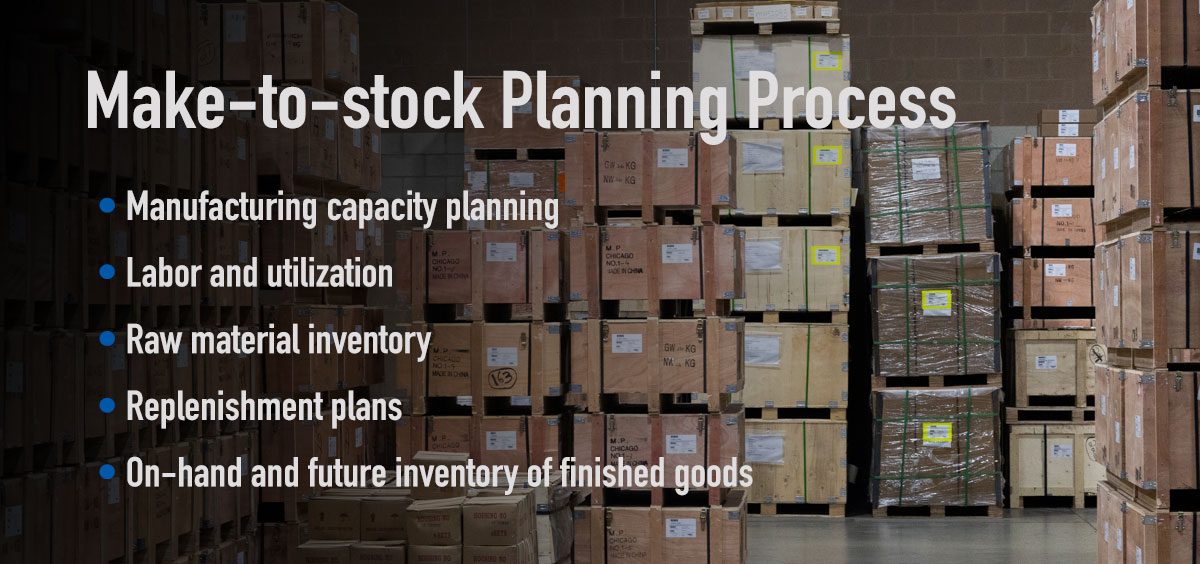What is Make-to-stock (MTS)?
Make-to-Stock (MTS) is a traditional approach to manufacturing, where companies produce goods based on anticipated demand. The production is planned and scheduled ahead of time, with the output from one production cycle intended to fulfill customer orders in the following cycle. In this system, production kicks off without waiting for specific customer orders.
MTS operations are ‘push’ systems. This means that the production process begins with the available supplies, such as raw materials and components from suppliers, and ‘pushes’ them through to the end as finished products. This is different from Make-to-Order (MTO) systems, which are ‘pull’ systems, initiating production based on individual customer orders.
In the current competitive landscape of manufacturing, holding large inventories of finished goods is generally seen as financially burdensome due to the costs of inventory management, storage, potential waste, and more. Similarly, having too little inventory can be expensive due to the need for rush orders, overtime work, and the risk of not meeting delivery deadlines.
The goal in MTS is to have just enough finished product available to meet customer demand in the upcoming period. Achieving this balance requires precise demand predictions and the ability to adjust production smoothly and quickly in response to any changes in forecasted demand.
Accurate demand forecasting and flexible planning tools are critical for effective MTS management. Forecasting is increasingly complex due to the expanding range of products manufacturers must consider and unpredictable factors that impact demand, such as natural disasters, health emergencies, and seasonal changes, among others.
Make-to-stock Planning Process
In addition to demand forecasting, effective make-to-stock planning must incorporate a complex web of considerations, including manufacturing capacity planning, labor and utilization, raw material inventory and replenishment plans, and on-hand and future inventory of finished goods.
Demand Forecasting
Gather historical sales data.
Analyze market trends, seasonality, and any foreseeable events that could affect demand.
Use statistical tools and software to project future sales volumes.
Inventory Analysis
Assess current inventory levels and turnover rates.
Calculate safety stock levels to guard against variability in demand or supply chain disruptions.
Determine reorder points and quantities.
Sales and Operations Planning (S&OP)
Align sales forecasts with production capacity.
Integrate input from different departments (sales, marketing, production, procurement, finance) to create a balanced plan.
Make decisions on inventory levels, staffing, production scheduling, and purchasing.
Master Production Scheduling (MPS)
Develop a timetable for production based on the S&OP outcomes.
Schedule the production runs to optimize machine utilization and labor.
Coordinate with suppliers to ensure the availability of materials for the scheduled production.
Material Requirements Planning (MRP)
Determine the required materials and components based on the MPS.
Schedule purchases and deliveries of raw materials to align with the production schedule.
Monitor inventory levels of raw materials to avoid production delays.
Production Execution
Implement the production plan.
Monitor the production process for efficiency and quality control.
Make adjustments as needed to deal with production variances.
Quality Control and Assurance
Inspect the finished goods to ensure they meet quality standards.
Implement quality improvement processes where necessary.
Finished Goods Inventory Management
Store the manufactured goods in inventory warehouses.
Maintain proper storage conditions and manage inventory handling.
Distribution Planning
Plan for the efficient distribution of products to various sales channels or distribution centers.
Ensure that transportation is lined up to meet delivery commitments.
Continuous Improvement
Collect data on the accuracy of forecasts, inventory turnover, and customer satisfaction.
Analyze performance metrics to identify areas for improvement.
Adjust the planning processes based on feedback and performance analysis.
The MTS planning process is cyclical and requires continuous monitoring and adjustment to adapt to changes in demand, market conditions, and production capabilities. It is heavily reliant on accurate data and effective communication across all departments within the organization.
MTS is best suited for products where demand is relatively stable and predictable. Common examples include industrial parts, basic consumer goods, such as food staples, household items, and certain clothing items.
However, if the market conditions are volatile and unpredictable, MTS can lead to either shortages or surpluses, both of which can be costly for the company. In contrast, strategies like Make-to-Order (MTO) or Just-in-Time (JIT) production are used where more customization is needed or where demand is less predictable.

Resourceful and innovative Marketing Pro, with 20+ years of progressive experience in the marketing and creative technology industry. Responsible for digital and traditional marketing efforts that promotes brand awareness, increases engagement, and drives revenue.




















